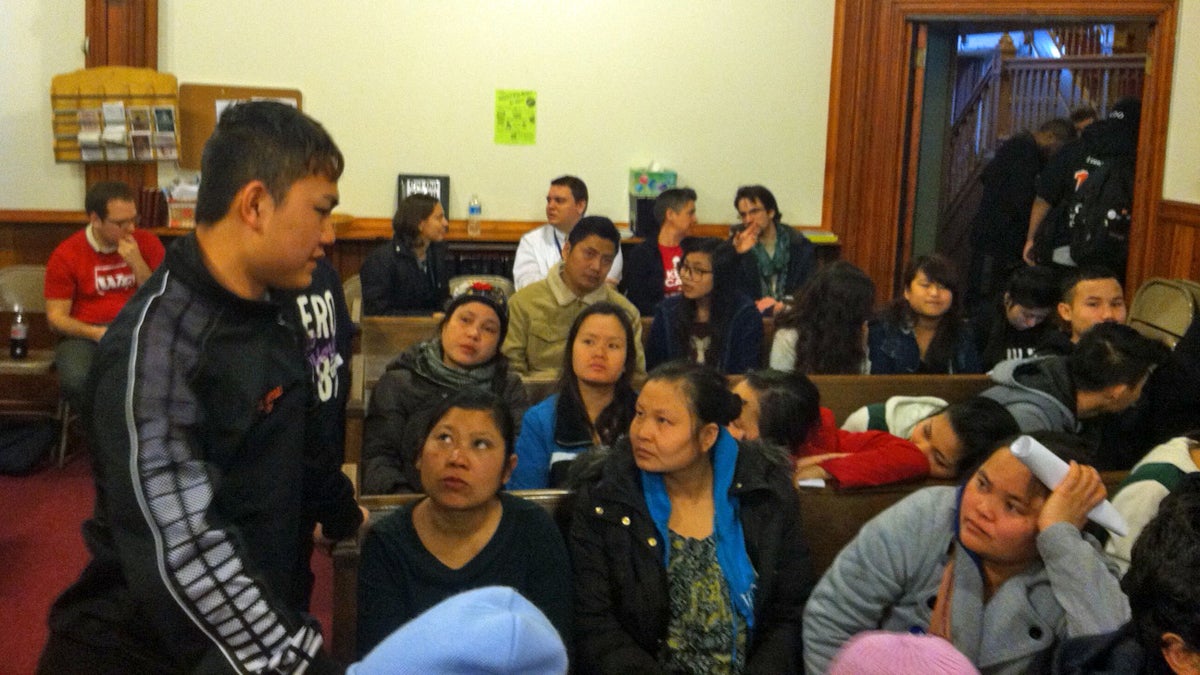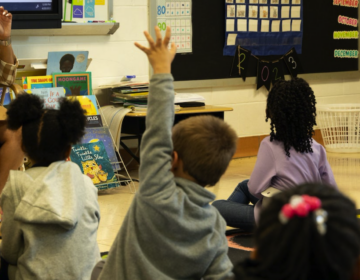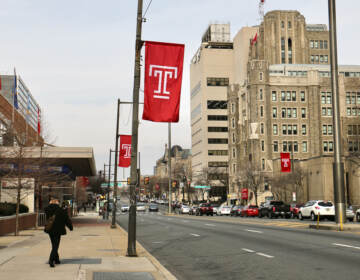Sanctions or success: Hundreds of Philly students opted-out of standardized tests this year
Listen
Furness High School student Lergay Htoo, translating information about opting out into Karen, a language spoken in Southeast Asia, at a community meeting earlier this year. (Laura Benshoff/WHYY)
This spring, Tonya Bah sent a letter to parents with children at Wagner Middle School in West Oak Lane, where her daughter Fulani is in the eighth grade.
In the letter, she shared why she didn’t think standardized tests helped students at Wagner, and explained how to opt them out using the School District of Philadelphia’s protocol.
“If enough of us refuse the tests,” Bah wrote, “the message to the state will be clear: We will not accept the label of failure for our students, for our schools.”
In all, 171 Wagner parents responded to the letter, pulling about a third of the students in the school out of statewide standardized tests call the Pennsylvania System of School Assessment or PSSAs.
Bah has fraternal twins in the eighth grade. Her daughter is an A-student, bound for Carver High School of Engineering and Science next year. Her son, Keiba, has verbal and physical disabilities, and attends Widener Memorial, a public school for students with disabilities.
She said seeing how different her kids’ needs are opened her eyes to the unfairness of testing that doesn’t drive instruction.
“I want there to be a follow through that tells them where they got it wrong and why they missed it,” said Bah. “You take a spelling test, and you get one wrong, you want to know what word you got wrong.”
Bah is one of a group of parents and advocates at the forefront of the “opt-out movement,” a grassroots organizing effort pushing back against testing they say eats up instruction time and can be harmful to students.
The movement has made headlines nationally, as parents in New York, New Jersey and Oregon pulled their children out of testing in unprecedented numbers.
This is the first year of concerted opt-out organizing in Philadelphia, and it shows in the number of opt-outs. Districtwide, 595 chose not to take the PSSAs; another 186 sat out the Keystone exams, a suite of three tests that will become part of a student’s graduation requirements in 2017. Many schools had high concentrations of students opting out. Some students also opted out of both exams, so there may be double-counting, according to Chris SHaffer, the district’s deputy chief of curriculum, instruction and assessment.
He said that’s considerably more than years past. “We had approximately 20 opt-outs last year,” he said.
Top 10 schools with the most opt-outs in Philadelphia
//
2015 PSSA and Keystone Opt Out Report (PDF) 2015 PSSA and Keystone Opt Out Report (Text)
Opting out: Growth and consequences
Bah said she hopes the opt-outs will get top-level educators to rethink standardized testing.
“The message to the state is, not only should you waive the Keystone exam as a requirement for a high school diploma, you should do away with it altogether,” she said.
Some in Harrisburg are considering altering the graduation requirement, but the wheels of legislative change turn slowly and revisions are not guaranteed.
In the meantime, tests scores are still used to record progress for state and federal accountability measures.
“The state’s position is that the exams are an indicator of student growth, they’re a snapshot in time that allow us to appropriately support schools,” said Matt Stem, deputy secretary with the Pennsylvania Department of Education.
At the state level, test scores go into a kind of report card, a School Performance Profile, for each school.
Rather than drag down a school’s test-grade average, Shaffer said, the state won’t include opt-outs in the grades at all.
“If I had a hundred students in third grade and 50 opted out, then the denominator wouldn’t be 100, it would be 50,” he explained.
In essence, those students aren’t counted. But who are they?
Many of the students opting out in large numbers are English-language learners or special education students, groups that tend to perform below average on standardized tests.
Not counting those students has the potential to skew school test results, although representatives from the state Department of Education “couldn’t speak to” how it would affect individual schools.
At Wagner, 24 percent of special education students opted out.
Opt-out advocate Tiffany Lorch teaches English-language learners (ELL) at Furness High School, which is over 40 percent ELL. A third of those students opted out of the Keystone exams.
Lorch said most of her students can’t pass the tests anyway. “I wouldn’t counsel somebody with potential to pass not to take it,” she said. But for most of her students, she said, “it’s not a realistic expectation.”
Not counting special populations, such as students learning English and special education students, raises red flags for some in the civil rights community. They argue that annual testing keeps federal and local governments accountable to their most vulnerable students. What’s more, they say, before annual testing was mandated, civil rights abuses were rampant in schools.
In response, opt-out supporters fire back that low test scores hurt those same communities and can be used as a reason to close schools or turn them into charters. Most charters in Philadelphia don’t serve as many ELL or special education students as district-run schools.
“I can’t fathom how that argument would trump that we’re not giving our kids the tools to pass,” said Lorch.
Federal dollars at stake?
Test scores and participation rates are also tied to federal funding. They figure in how the federal government rates schools that get Title I funding, a pot of money for schools with a high proportions of students in poverty.
“If a child is opted out, a school’s participation rate decreases,” said Stem. “A Title I school that fails to achieve a 95 percent participation rate will be placed into the ‘focus’ status of the federal accountability.”
All Philadelphia schools qualify for Title I funding.
In the national conversation about opting out, states with lots of kids refusing tests were threatened with economic sanctions, in the form of losing some federal funds.
But for an individual school with lots of opt-outs, the outcome could be the exact opposite.
“Based on [the focus] designation, the state is required to provide additional supports to that school and that the school is monitored federally,” said Stem.
Does that mean a school that gets a focus designation would get more resources and attention? “That’s correct,” said Stem.
However, the Philadelphia schools with the most opt-outs are already in the higher need focus or priority categories. Since they already receive additional supports and monitoring, they won’t see any more funding.
For the state’s test scores to draw sanction, more than 5 percent of all Pennsylvania students would have to refuse testing.
Given that standard, Philadelphia’s opt-outs rate is still relatively low. Some suburbs saw a greater proportion of their students opt-out than Philadelphia. In the Lower Merion School District, a district one-twentieth the size of Philadelphia, 272 students opted out of PSSAs.
That’s still a large increase over Lower Merion’s opt-out rate last year, something opt-out advocates view as a victory.
And if the state doesn’t change its focus on testing, parents will keep organizing, said Bah. “If you don’t handle this, we aren’t waiting for you.”
WHYY is your source for fact-based, in-depth journalism and information. As a nonprofit organization, we rely on financial support from readers like you. Please give today.




